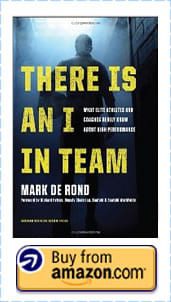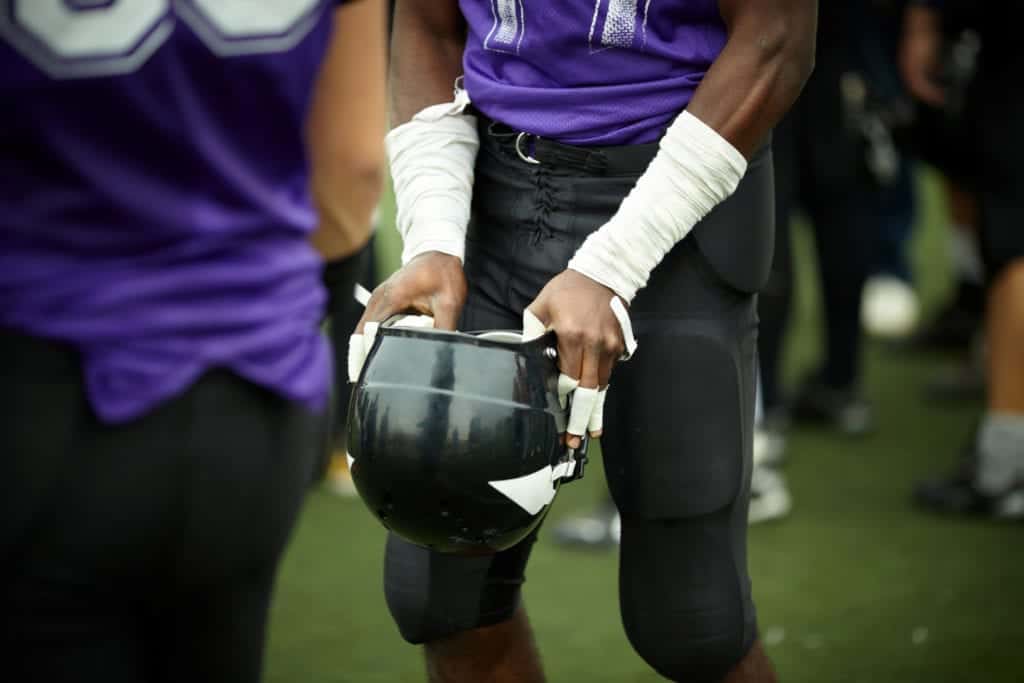Overview of There is an I in Team by Mark De Rond
An interesting book with some fascinating coaching stories, well worth the read for those who love getting an insight into other sports programs.
Upfront, you should know that this is a business book that uses sport as the examples and basis of discussion. As the author writes: “Though sports metaphors permeate business parlance, my goal in this book is to offer managers and anyone on a team in business some real, substantive ideas about how to be a better player – or manager – based on what we know from the world of elite sports.”
The book looks at the sporting world for ways that the business world can improve individual and team performance. As almost all of our clients and contacts are involved in sport, I thought it important to make this clarification. This book hasn’t been written for sports people, but as someone involved in sport, it is still valuable.
It is a book I would ‘recommend’ if you have time and love to read, but if you have minimal time and only manage to get through a couple of books a year, I’d like suggest something else. I mean no disrespect to the author, it is a great book, I did enjoy it and when I flick through it now, there are lots of spots underlined and marked, so I obviously did find many valuable parts (I share my favorite parts below too).
“There is an I in Team” is about the challenge of bringing talented individuals together in a high-performance team and the leadership challenges of capturing and optimizing the individuals’ influences on the team as a whole. Interestingly it opens with a Michael Jordan quote “There may not be an I in Team… but there is in Win.”
A key themes of the book is “insights from the world of sports showing that significant improvement in performance could be a catalyzed by a better understanding – and management – of the inherent tensions between the individuals and the team.” The book focuses unashamedly on the individual in the context of other individuals and highlights research conclusions such as a person’s likability can trump competence in his/her effect on team performance.
Each chapter within the book focuses on what the author believes is a commonly held, but incorrect, belief about teams. Within the chapter it then provides sporting examples of why these beliefs are false and provides an alternative way to approach elite individuals and team performance.
The book covers why:
- there is an I in team – and why that matters,
- the best team rarely ever comprises the best individual performers,
- conflict happens even as intentions are perfectly aligned,
- likability can trump competence in even technically sophisticated environments,
- a focus on interpersonal harmony can actually hurt team performance.
Why There is an I in Team
The book’s first chapter explores the assertion that the qualities that make an individual attractive and valuable to the team, also make them difficult. (We often talk about this same topic as someone’s strengths, if overused, can become their weaknesses or challenges.) It highlights that the best individuals put together do not necessarily make for the best team. “Conflict often arises even as people agree on what needs to be done and why… It can make sense to trade off competence for likability within a team in even technically demanding environments. Competition within teams can be as valuable as collaboration.”
“What may appear like picture-perfect teams are then in reality often quite intricate tapestries of distinct characters united by a common goal but forced into a sanctum where trade-off choices must be made between likability and competence; where powerful but conflicting pressures coexist; where one’s success hinges on being able to reconcile camaraderie and rivalry, trust and vigilance, the sacred and the profane; and where they end up getting it wrong as often as right.”
De Rond shares a number of examples of high-profile sports and non-sports people such as baseball star Pete Reiser, soccer manager Fabio Capello and Steve Jobs. The qualities that made these individuals so extraordinarily gifted, also made them extraordinarily difficult to work with. “Couldn’t work with him. Wouldn’t want a world without him.”
One of the solutions De Rond provides is to start by becoming more aware of our own behavior and to set clear limits as to what behavior is or isn’t acceptable to the team. The risk of any one person derailing the team can be managed by helping each person understand the possibility of their behavior thwarting their own potential and that of the team. He gives a great example of this in practice with Coach Mike Kryzewski, of Duke University, holding meeting to challenge his staff and players to think of as many irritants as possible and – in the spirit of “let’s not let Duke beat Duke” – have them openly discussed and dealt with.
The “Stephens Question”, which is named after the Cambridge University Boat Club manager, is to distill everything down to a compelling and simple purpose. Roger Stephens was famous for asking: Will doing this make the boat faster?. “The answer is ultimately a straightforward yes or no. Notwithstanding the fact that most workplaces are vastly more complex in their pursuit of multiple objectives, would it help to try and distill, at the level of the team, an equivalent Stephens Question?
Rather than summaries the entire book, instead I’ve shared my favorite parts of the book below…
My favorite parts of There is an I in Team
Many of my favorite parts of the book are interesting studies and statistics such as:
Sport over Academics
“A recent survey of a hundred randomly selected CEOs of the UK’s five hundred largest companies found that 46% of the CEOs had won awards for their athletic prowess (by comparison, only 23% had accumulated awards for academic achievement). 71% believed that compulsory sports at school shaped their business acumen in a positive way.” (Page xvi)
All-Stars Matter
“A basketball team without superstars rarely makes it to the playoffs, let alone the finals…. In fact, a team with no starting all-star players has less than a 1/100th chance of winning the championship. By comparison, a team with an all-star player raises the odds of winning to 7.1 percent and of making it to the finals to 16 percent.
The odds increase dramatically as the number of star players per team increases…. Field two first-team all-star players have a one-in-four chance of winning a championship and better than a one-in-three chance of making the finals. With three all-stars, the odds increase to 39 percent and 77 percent, respectively…. Love them or loathe them, individuals matter.” (Page 2)
We back ourselves more than others
“two questions asked of 1,800 senior managers…Firstly… how confident are you in your own ability to make good choices? Reassuringly, 83 percent of respondents said they were either “confident” or “very confident” of their ability to make good choices when it came to their professional lives. The second question, as usual, proved the more insightful: How confident are you in the ability of those you work with most closely to also make good choices? … only 27% percent were either “confident” or “very confident” of the ability of their colleagues… these survey results illustrate not just our tendency to overestimate our own abilities, but worryingly, our underestimating the ability of others .” (Page 13-14)
Touching is good
“…a recent study by University of California-Berkeley psychologists on the effect of touch on team performance. By coding the touch behavior of 294 players from all thirty NBA teams during the 2008-2009 season, they discovered that frequent touching early on predicted greater performance for teams as well as individuals later in the season. When controlling for player status, preseason expectations, and early season performance, their hypothesis that touch predicted improved performance still held. Intuitively this makes sense. By touching – using high fives, chest bumps, leaping shoulder bumps, chest punches, head slaps, head grabs, low fives, high tens, full hugs, and team huddles – we communicate cooperation, and help lay to rest the anxieties experienced by others in communicating affect, reassurance, and trust.” (Page 22)
Being liked is more important than being good
“Academic research by Tiziana Casciaro and Miguel Sousa Lobo…The analysis suggests that if someone is strongly disliked, it is almost irrelevant whether or not he is competent. By contrast, if someone is liked, her colleagues will seek out every bit of competence she has to offer, meaning that a little likability has far more mileage then competence in making someone a desirable team member… KPMG’s Steve Hollis frames this trade-off as the 80/20 rule. In his experience, professionals typically rate their technical excellence as accounting for 80 percent of their success, with the remaining 20 percent due to the quality of their relationships with clients. The dichotomy is that the very same clients take the professional’s technical excellence for granted and the dominant determining factor is the quality of the relationship .” (Page 38)
We judge teamwork depending on the outcome
“To demonstrate the effect of perceptions of performance on team harmony, University of California-Berkeley’s Barry Shaw designed a clever experiment. Using a sizable sample, he supplied teams with false feedback on their performance before asking them to provide objective descriptions of how they felt their team members had interacted with each other while performing the requisite task. Teams that were told that they had performed well, regardless of actual performance, also reported more harmonious relationships. By contrast, those who had been told their teams had underperformed were much less flattering about their teammates and far more pessimistic in evaluating the intergroup dynamics while at work.” (Page 57)
Trust in the coach is more important than in teammates
“Evidence from NCAA basketball suggests that, when it comes to team performance, trust placed in coaches is more important than that among teammates. Survey results…show a distinct relationship between high levels of trust in the coach and performance insofar as trust in leadership allows players to suspend their questions, doubts, and personal motives and instead fully participate in whatever the team is required to do.” (Page 64)
When it comes to safety, familiarity matters
“When it comes to the importance of stability, evidence from the airline industry is compelling as well. A U.S. National Transportation Safety Board investigation in 1994 discovered that 73 percent of all in-flight incidents occur on the first day a particular flight crew works together…. it also concluded that fatigued flight crews or those that had already flown together for several days caught and corrected more errors than did well-rested crews just starting out.” (Page 66)
Coincidence and what made me cry…
What I haven’t mentioned yet about this book (yes, I left it to those committed to reading the review right to the end!), was the co-incidence that occurred at the time I was reading it. It just so happened, that while this book was the object of my reading focus, Olympic Rowing Coach, Tim McLaren and his wife visited us for a day or two. Tim had actually been present at a number of rowing events documented in the book. I was fascinated to hear Tim’s perspective on what had happened and those involved.
Of my particular interest was the stories of the Great Brittain Olympic selection for the men’s eight. It had been the part of the chapter on Why Inequality Is a Good Thing about Bob Thatcher, that had made cry. Ok, I am prone to cry in movies, but books rarely have that effect on me and especially business books! It is the pages leading up to page 43 that had such an effect on me… I felt devastated for Bob Thatcher and the tough reality of the situation. I couldn’t help but think how things could have been different. Anyway, if you read the book, you’ll know what I mean.
I trust you enjoyed this book review. As always, I’d love your feedback and comments, so please Contact Us. To view more of the books we recommend, head to our Book Section.




